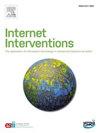Impact of the best possible self intervention on affective well-being in early adolescence: A randomized controlled online trial
IF 4.1
2区 医学
Q1 HEALTH CARE SCIENCES & SERVICES
Internet Interventions-The Application of Information Technology in Mental and Behavioural Health
Pub Date : 2025-04-08
DOI:10.1016/j.invent.2025.100827
引用次数: 0
Abstract
The Best Possible Self intervention (BPS) has demonstrated efficacy in promoting well-being in various populations, yet its impact in adolescence is under-researched. Our study investigated the feasibility and efficacy of the BPS in early adolescence (11–15 years) to promote positive affect and reduce negative affect. We conducted a randomized controlled online trial (N = 200, Mage = 14.01 years, SD = 1.19, 78.5 % female). Participants were assigned to the BPS group (n = 59), a writing control group (n = 68), or a non-writing control group (n = 73). Affect (PANAS-C-SF) was measured immediately before and after the intervention. The BPS demonstrated feasibility in our sample and significantly increased positive affect post-intervention compared to both control groups, suggesting a mood-boosting effect. The BPS did not significantly reduce negative affect post-intervention relative to the control groups. Our findings provide initial evidence that the BPS is a feasible and effective intervention for enhancing positive affect in early adolescence. Future research should explore its long-term effects, repeated administration, and potential for implementation in group settings to maximize its impact.
最佳自我干预对青少年早期情感幸福感的影响:一项随机对照在线试验
最佳自我干预(Best Possible Self intervention, BPS)在促进不同人群的幸福感方面已被证明有效,但其对青少年的影响尚未得到充分研究。本研究探讨了青少年早期(11-15岁)BPS在促进积极情绪和减少消极情绪方面的可行性和有效性。我们进行了一项随机对照在线试验(N = 200,年龄= 14.01,SD = 1.19,女性占78.5%)。参与者被分为BPS组(n = 59)、写作控制组(n = 68)和非写作控制组(n = 73)。在干预前后立即测量影响(PANAS-C-SF)。BPS在我们的样本中证明了可行性,并且与两个对照组相比,干预后显著增加了积极影响,表明有促进情绪的作用。与对照组相比,BPS并没有显著减少干预后的负面影响。我们的研究结果提供了初步的证据,证明BPS是一种可行和有效的干预措施,可以增强青少年早期的积极影响。未来的研究应探索其长期效果、重复管理和在群体环境中实施的潜力,以最大限度地发挥其影响。
本文章由计算机程序翻译,如有差异,请以英文原文为准。
求助全文
约1分钟内获得全文
求助全文
来源期刊

Internet Interventions-The Application of Information Technology in Mental and Behavioural Health
Medicine-Health Informatics
CiteScore
6.50
自引率
9.30%
发文量
94
审稿时长
6 weeks
期刊介绍:
Official Journal of the European Society for Research on Internet Interventions (ESRII) and the International Society for Research on Internet Interventions (ISRII).
The aim of Internet Interventions is to publish scientific, peer-reviewed, high-impact research on Internet interventions and related areas.
Internet Interventions welcomes papers on the following subjects:
• Intervention studies targeting the promotion of mental health and featuring the Internet and/or technologies using the Internet as an underlying technology, e.g. computers, smartphone devices, tablets, sensors
• Implementation and dissemination of Internet interventions
• Integration of Internet interventions into existing systems of care
• Descriptions of development and deployment infrastructures
• Internet intervention methodology and theory papers
• Internet-based epidemiology
• Descriptions of new Internet-based technologies and experiments with clinical applications
• Economics of internet interventions (cost-effectiveness)
• Health care policy and Internet interventions
• The role of culture in Internet intervention
• Internet psychometrics
• Ethical issues pertaining to Internet interventions and measurements
• Human-computer interaction and usability research with clinical implications
• Systematic reviews and meta-analysis on Internet interventions
 求助内容:
求助内容: 应助结果提醒方式:
应助结果提醒方式:


